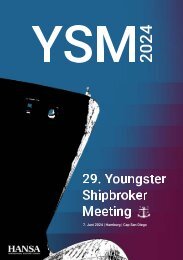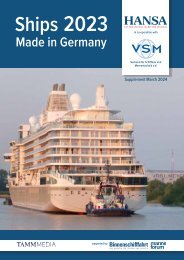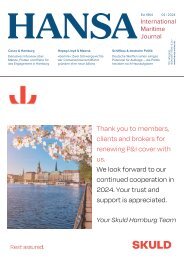HANSA 03-2018
Propeller Performance | Koalitionsvertrag | Jubiläum ZVDS | Robotik im Hafen | Ballastwasser Survey 2018 | Finanz- und Schifffahrtsstandort Nordamerika | Zeaborn & Rickmers
Propeller Performance | Koalitionsvertrag | Jubiläum ZVDS | Robotik im Hafen | Ballastwasser Survey 2018 | Finanz- und Schifffahrtsstandort Nordamerika | Zeaborn & Rickmers
Erfolgreiche ePaper selbst erstellen
Machen Sie aus Ihren PDF Publikationen ein blätterbares Flipbook mit unserer einzigartigen Google optimierten e-Paper Software.
Schiffstechnik | Ship Technology<br />
About 40,000 vessels worldwide need to have a<br />
Ballast Water Treatment System on board<br />
Photo: Techcross<br />
One man’s curse is another man’s blessing<br />
On 8 September 2017 the Ballast Water Management Convention (BWMC) entered into<br />
force. But shipowners successfully obtained a delay for existing vessels and thus have more<br />
time to install treatment systems on board. By Thomas Wägener<br />
On the one hand, the decision by the<br />
International Maritime Organization<br />
(IMO) to grant vessels built prior to<br />
8 September 2017 two more years before<br />
they require a BWTS on board has led to<br />
relief among shipping companies. On the<br />
other hand, suppliers are upset because<br />
they were hoping for an advance, led by<br />
complex technology. According to the<br />
original plans, the ballast water agreement<br />
was to enter into force earlier. This<br />
would have resulted in many ships to provide<br />
such a technology on board as soon<br />
as last year. At the latest, all ships would<br />
have had a BWTS installed on board by<br />
September 2022. Now operators/owners<br />
have to implement the facilities until the<br />
final deadline in September 2024 (see also<br />
<strong>HANSA</strong> 8/2017, p. 54).<br />
However, the shipping companies have<br />
successfully rebelled against the original<br />
plans – and prevailed, because they were<br />
able to push a delay. The rationale presented<br />
was that available facilities were<br />
not ready for the market, yet. Furthermore,<br />
the costs would be to high for many<br />
of the shipowners, and in addition, the<br />
shipping companies referred to the problem<br />
of not clearly defined regulations. A<br />
competing legal framework in different<br />
areas of the world would rather complicate<br />
the situation, given the U.S. specifications<br />
for example, they said.<br />
The new BWMC has a massive impact<br />
on the shipping sector worldwide.<br />
The investment for one BWTS could total<br />
2 mill. €. Esben Poulsson, Chairman<br />
of the International Chamber of Shipping<br />
(ICS) thus estimated some 100 bn. € overall<br />
costs for the whole maritime industry.<br />
Poulsson urges shipowners, ballast-water<br />
system manufacturers and governments<br />
to cooperate for the success of the convention,<br />
and to increase the potential for environmental<br />
protection. Owners should<br />
now use the time to invest in better technology,<br />
says Poulsson. Andrew Marshall,<br />
Coldharbour Marine CEO, also urges for<br />
making good use of the additional time:<br />
»Many ship operators require a far better<br />
understanding of ballast water treatment<br />
technologies and their shortcomings in real-life<br />
applications.«<br />
Desmi improves test bed<br />
One of the companies that worked on<br />
their BWTS recently is the Danish manufacturer<br />
Desmi. Its latest test bed, completed<br />
at the end of 2017, works with a<br />
wider scope of testing scenarios, and it<br />
enables customers to gain access to a new,<br />
expanded set of testing certification services.<br />
»We’ve made a considerable investment<br />
to upgrade our existing test<br />
bed with complete, state-of-the-art technology,«<br />
said André Jelstrup, Production<br />
Manager at Desmi. »With eight different<br />
test bases, each equipped to handle<br />
pumps of varying sizes and types, we’ve<br />
now got far greater flexibility.«<br />
The new test bed can be both upgraded<br />
and expanded down the line which is<br />
equally relevant, Desmi stated. The company<br />
sees a vast improvement in upgrading<br />
their test bed technology. Once a<br />
pump is secured on its skid, an auto-cycle<br />
fills the pump cylinder with liquid, pushes<br />
the air out and automatically tests various<br />
points on a pre-determined pump curve.<br />
All the while, two viewing monitors provide<br />
a continuous and complete readout of<br />
the test results. Tolerances can also be accurately<br />
measured providing a significantly<br />
larger data set than the previous system,<br />
Desmi emphasises. This latter feature can<br />
be used to refine designs or catch problems<br />
at a much earlier point during testing.<br />
Wärtsilä has improved its BWTS as well.<br />
According to the company, both Aquarius<br />
technologies are IMO approved, USCG<br />
Alternate Management System (AMS) accepted,<br />
and both are currently undergoing<br />
full USCG and ballast discharge regulation<br />
(Revised G8) testing. Wärtsilä<br />
expects the EC USCG type approval during<br />
the second half and the UV type approval<br />
for the last quarter of this year.<br />
New order for Optimarin<br />
Recently, Optimarin announced another<br />
order from Ahrenkiel Steamship for its<br />
Optimarin BWTS, also known as OBS.<br />
The OBS 334-370 BK has a capacity of<br />
334 m3/h and will be installed on »AS Laguna«.<br />
According to Optimarin it takes<br />
four to eight days to install a BWTS on<br />
board with a capacity of 500 m3/h.<br />
Due to the fact that about 40,000 vessels<br />
worldwide need to be fitted with ballast<br />
water treatment systems in the coming<br />
years, the installation time could be<br />
one of the decisive factors. <br />
M<br />
54 <strong>HANSA</strong> International Maritime Journal – 155. Jahrgang – <strong>2018</strong> – Nr. 3


















